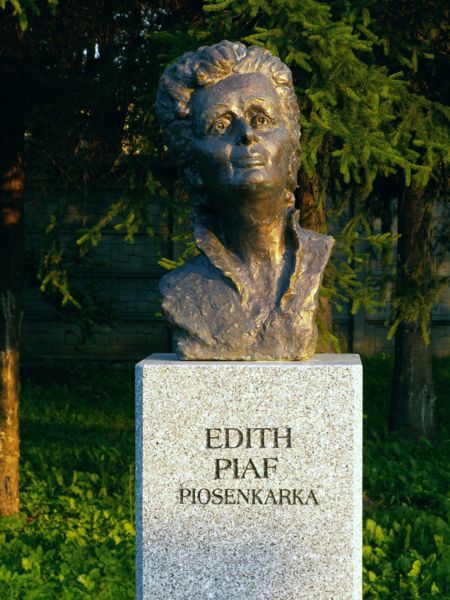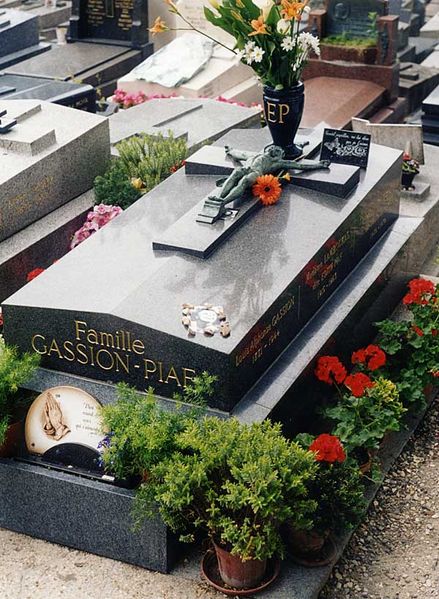 Edith Piaf (December 19, 1915–October 11, 1963) was one of France's most beloved singers, and became a national icon. Her singing reflected her tragic life, with her specialty being the poignant ballad performed in a heartbreaking voice. Among her famous songs are "La vie en rose" (1946), "Hymne à l'amour" (1949), "Milord" (1959), "Non, je ne regrette rien" (1960). A filmed biography on her life, entitled La Vie En Rose, was released in the US in the summer of 2007. There have been other dramatized versions of her life, including a Tony Award-winning play entitled Piaf, which was also telecast on PBS.
Edith Piaf (December 19, 1915–October 11, 1963) was one of France's most beloved singers, and became a national icon. Her singing reflected her tragic life, with her specialty being the poignant ballad performed in a heartbreaking voice. Among her famous songs are "La vie en rose" (1946), "Hymne à l'amour" (1949), "Milord" (1959), "Non, je ne regrette rien" (1960). A filmed biography on her life, entitled La Vie En Rose, was released in the US in the summer of 2007. There have been other dramatized versions of her life, including a Tony Award-winning play entitled Piaf, which was also telecast on PBS.
Contents
Early life
Despite numerous published biographies, many facts and events of Édith's life are shrouded in mystery. She was born Édith Giovanna Gassion in Belleville, Paris, the high-immigration district later described by Daniel Pennac. Legend has it that she was born on the pavement of Rue de Belleville 72, but her birth certificate states she was born at Hôpital Tenon, the hospital for the 20th arrondissement of which Belleville is part. She was named Édith after the World War I British nurse Edith Cavell, who was executed for helping French soldiers escape from German captivity. Piaf—a Parisian colloquialism for "sparrow"—originated as a nickname she would receive twenty years later.
Her mother, Annetta Giovanna Maillard (1895–1945), was a part-Italian native of Livorno, a port city on the western edge of Tuscany, Italy. She was working as a café singer under the name Line Marsa. Louis-Alphonse Gassion (1881–1944), Edith's father, was a street acrobat with a past in the theatre. Little Édith was soon abandoned by her parents, lived for a short time with her maternal grandmother, Emma (Aïcha) Saïben Mohammed (1876–1930), (a Kabyle). Shortly thereafter, Édith's father took the child to his mother, who ran a brothel in Normandy, and he then joined the French Army (1916). Thus, Édith was in contact with the prostitutes and the various attendees of the brothel since her early years, a circumstance which must have had a deep impact on her personality and view of life.
From the age of three to seven Édith was allegedly blind, suffering from an eye condition, most likely keratitis or iritis; and from eight to fourteen she was allegedly deaf. According to one of Piaf's biographies, she recovered her sight in what is known as a "miracle", after her grandmother's prostitutes pooled money to send her on a pilgrimage honoring Saint Thérèse de Lisieux. In 1929, at fourteen, she joined her father in his acrobatic street performances. She then took a room at Grand Hôtel de Clermont (18 rue Veron, Paris 18ème) and separated from him, going her own way as a street singer in Pigalle, Ménilmontant, and the Paris suburbs (cf. the song "Elle fréquentait la Rue Pigalle"). She was about sixteen years old when she fell in love with a delivery boy, Louis Dupont. Shortly afterward she had her only child, a little girl named Marcelle, who died at the age of two of meningitis.
Singing career
In 1935, Édith was discovered by the nightclub owner Louis Leplée, whose club was frequented by the upper and lower classes alike. He persuaded her to sing despite her extreme nervousness, which, combined with her height of only 4 feet 8 inches (1.47 m), inspired him to give her the nickname that would stay with her for the rest of her life and serve as her stage name, La Môme Piaf (The Waif Sparrow). Her first record was produced in the same year. Shortly afterward, Lepléwas murdered and Piaf was accused of being an accessory, but she was acquitted.
In 1940, Jean Cocteau wrote the successful play Le Bel Indifférent, intended for Édith as the star. She began to make friends with famous people, such as the actor Maurice Chevalier and the poet Jacques Borgeat. She wrote the lyrics of many of her songs and collaborated with composers on the tunes. In 1944, Édith Piaf discovered Yves Montand in Paris, made him part of her act, and became his mentor and lover.
During this time, she was in great demand and very successful. Singing for high-ranking Germans at the One Two Two Club earned Piaf the right to pose for photographs with French prisoners of war, ostensibly as a morale-boosting exercise. She gave the photos to underground workers who made counterfeit passports for all 150 captives. After returning to the camp again, Piaf secretly transferred the passports to the Frenchmen, and some of them managed to escape. Today, Piaf's association with the French Resistance is well known, and many former Resistance members owe their lives to her.
After the war, she toured Europe, the United States, and South America, becoming an internationally known figure. Her popularity in the United States was such that she appeared on the Ed Sullivan Show eight times and at Carnegie Hall twice (1956 and 1957). She helped to launch the career of Charles Aznavour, taking him on tour with her in France and the United States.
Her signature song "La vie en rose" (which was voted a Grammy Hall of Fame Award in 1998) was written in 1945.
The great love of Piaf's life, the boxer Marcel Cerdan, died in a 1949 plane crash. Piaf was married twice. Her first husband was Jacques Pills, a singer. They married in 1952 and divorced in 1956. Her second husband, Théo Sarapo, was a twenty-six-year-old hairdresser-turned-singer and actor, twenty years younger than Piaf. They married in 1962. By all accounts he was very taken with Piaf and doted on her till the end.
In 1951 she was involved in a car accident, and thereafter had difficulty breaking a serious morphine addiction.
The famed Paris Olympia concert hall is where Piaf achieved lasting fame, giving several series of concerts at the hall between January 1955 and October 1962. Excerpts from five of these concerts (1955, 1956, 1958, 1961, 1962) were issued on record and CD and have never been out of print. In April 1963, Piaf recorded her last song, "L'homme de Berlin".
Death and legacy
 At the early age of 47, Piaf died of cancer at Plascassier, on the French Riviera, on October 11, 1963, the same day that her friend Jean Cocteau died. She was buried in Père Lachaise Cemetery, in Paris. Although she was denied a funeral mass by the Roman Catholic archbishop of Paris (because of her lifestyle), her funeral procession drew hundreds of thousands of mourners onto the streets of Paris and the ceremony at the cemetery was attended by more than forty thousand fans. Charles Aznavour recalled that Piaf's funeral procession was the only time since the end of World War II that he saw Parisian traffic come to a complete stop.
At the early age of 47, Piaf died of cancer at Plascassier, on the French Riviera, on October 11, 1963, the same day that her friend Jean Cocteau died. She was buried in Père Lachaise Cemetery, in Paris. Although she was denied a funeral mass by the Roman Catholic archbishop of Paris (because of her lifestyle), her funeral procession drew hundreds of thousands of mourners onto the streets of Paris and the ceremony at the cemetery was attended by more than forty thousand fans. Charles Aznavour recalled that Piaf's funeral procession was the only time since the end of World War II that he saw Parisian traffic come to a complete stop.
There is a museum dedicated to Piaf, the Musée Édith Piaf at 5, rue Crespin du Gast, 75011, Paris.
Her song "Tu es partout" is featured in the movie Saving Private Ryan.
Today she is still remembered and revered as one of the greatest singers of France.
A film of Piaf's life by Olivier Dahan, La Vie En Rose, debuted at the Berlin Film Festival in February, 2007. Titled La Môme in France, the film stars Marion Cotillard as Piaf. Dahan's film follows Piaf's life from early childhood to her death in 1963. David Bret's definitive biography, Piaf, A Passionate Life, was re-released by JR Books to coincide with the film's release.
Songs
* "Mon légionnaire" (1936)<
br /> * "Le Fanion de la Légion" (1936)
* "Tu es partout" (1943)
* "La Vie en rose" (1945)
* "Les Trois Cloches" (1945)
* "Hymne à l'amour" (1949)
* "Padam… Padam…" (1951)
* "Sous le ciel de Paris" (1954)
* "Les Amants d'un jour" (1956)
* "La Foule" (1957)
* "Milord" (1959)
* "Non, je ne regrette rien" (1960)
* "Les neiges de Finlande" (1958)
* "Au bal de la chance" (1952)
Her song Hymne à l'amour inspired the film Toutes ces belles promesses by Jean-Paul Civeyrac. It was also translated into English as "If You Love Me (Really Love Me)" and covered by various artists including Kay Starr, who had a hit with it in 1954.
Films
Appeared in
* La garçonne (1936), Jean de Limur
* Montmartre-sur-Seine (1941), Georges Lacombe
* Étoile sans lumière (1946), Marcel Blistène
* Neuf garçons, un cœur (1947)Georges Freedland
* Al diavolo la celebrità (1949) Mario Monicelli Steno
* Paris chante toujours (1951), Pierre Montazel
* Boum sur Paris (1953), Maurice de Canonge
* Si Versailles m'était conté (1954), Sacha Guitry
* French cancan (1954), Jean Renoir
* Les Amants de demain (1959), Marcel Blistène
Plays
* Piaf (1978), by Pam Gems
"Le Bel Indifférent" Cocteau's play written for and starring Édith Piaf
Discography
* The Voice of the Sparrow: The Very Best of Edith Piaf, original release date: June, 1991
* Edith Piaf: 30th Anniversaire, original release date: April 5, 1994
* Edith Piaf: Her Greatest Recordings 1935-1943, original release date: July 15, 1995
* Hymn to Love: All Her Greatest Songs in English, original release date: November 4, 1996
* Gold Collection, original release date: January 9, 1998
* The Rare Piaf 1950-1962 (April 28, 1998)
* La Vie en Rose (import), original release date: January 26, 1999
* Montmartre Sur Seine (soundtrack import), original release date: September 19, 2000
* Eternelle: The Best Of (January 29, 2002)
* Love and Passion (boxed set), original release date: April 8, 2002
* The Very Best of Edith Piaf (import), original release date: October 29, 2002
* 75 Chansons (Box set/import), original release date: September 22, 2005
* 48 Titres Originaux (import), (09/01/2006)
About
* Edith et Marcel (1983), Claude Lelouch
* La Môme (La Vie En Rose outside of France) (2007) , Olivier Dahan with Marion Cotillard as Edith Piaf
Edith Piaf on DVD
* Edith Piaf – A Passionate Life (May 24th, 2004)
* Edith Piaf : Eternal Hymn (Éternelle, l'hymne à la môme, Non-US Format, Pal, Region 2, Import)
* Piaf – Her Story, Her Songs (June 2006)
Books on Edith Piaf
* The Wheel Of Fortune: The Autobiography of Edith Piaf by Edith Piaf (originally written in 1958, 5 years before her death), Peter Owen Publishers; ISBN 0720612284
* Edith Piaf, by Edith Piaf and Simone Berteaut, published January 1982; ISBN 2904106014
* The Piaf Legend, by David Bret, Robson Books,1988.
* Piaf: A Passionate Life, by David Bret, Robson Books, 1998, revised JR Books, 2007
This article is licensed under the GNU Free Documentation License . It uses material from the Wikipedia article on Edith Piaf
1
Comment On Edith Piaf
【楽天市場】BABY-G ベビーG ベビージー 正規品BGD-1030-1JFカシオ CASIO 腕時計 送料無料:e
情報、良いを助けるためそれを感謝しています。 。 ‘それは夢にこだわると生きることを忘れないようにしません。」 JKローリングによって
【楽天市場】BABY-G ベビーG ベビージー 正規品BGD-1030-1JFカシオ CASIO 腕時計 送料無料:e-mix http://www.javatech.cn/eminiexchange/2584.html